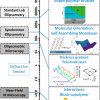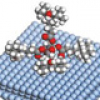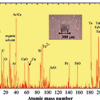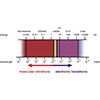Articles
Following our articles on the FAIR initiative, we now look at some examples of the FAIRification of data handling, collection and archiving.
In this article the question of the certification of calibration samples for the characterisation of advanced thin film materials is addressed within the framework of reliable process control or quality management purposes. Reference measurement techniques can be used in order to address the gap in appropriate certified reference materials (CRMs) for thin film analyses. They allow for qualifying out-of-production samples originating from an operating production line as calibration samples. As a template for this procedure, CIGS [Cu(In,Ga)Se2] layers, that are absorber layers for high efficiency thin-film solar cells, have been used for establishing and validating reference-free X-ray fluorescence (XRF) analysis and Auger-electron spectroscopy (AES) as reference measurement techniques.
This article tells us about another: “Fast and versatile ambient surface analysis by plasma-assisted desorption/ionisation mass spectrometry”. They show that surface analysis can greatly benefit from approaches using surface–plasma interactions and that PADI shows significant promise to become a valuable and versatile tool for this.
The authors describe “Infrared mapping spectroscopic ellipsometry”. Recent developments in fundamental and materials research have increased the value of mapping techniques such as ellipsometry. IR ellipsometry, since it operates in the mid-IR fingerprint region, provides complementary information on composition, structural properties and interactions
A complication and barrier to wider uptake of SIMS, especially for organic materials, is the complexity of the mass spectrum. The G-SIMS method (from gentle-SIMS) was developed to simplify the spectra and provide direct interpretation based on the physics and chemistry of the SIMS process rather than on statistical analysis techniques such as principal component analysis or library matching methods.
After an introduction to MALDI, DESI and SIMS, the authors describe their main applications in forensics, as well as the advantages provided in terms of sample preparation over approaches routinely used in toxicological laboratories.
The purpose of this article is to give a comparative description of two methods applying ion-beam sputtering in materials research: secondary ion and neutral mass spectrometries (SIMS and SNMS). We shall illustrate the application of the latter by reports on a compositional analysis of perovskite oxides and on an investigation of nanoscaled multilayer structures.
Thin polymer layers on solid substrates are of high technological importance due to their increasing potential for applications in electronics, sensors, nanotechnology and biotechnology. Appropriate characterisation methods are necessary for the design and analysis of devices made using such materials. This review article focuses upon presenting the many analytical possibilities for quantitative evaluation of the optical constants and thickness of polymer layers by combined application of spectroscopic ellipsometry (SE) in the visible (vis) and infrared (IR) spectral range.
John Walton
Surface Analysis Coordinator, School of Materials, The University of Manchester, PO Box 88, Manchester, M60 1QD, UK. E-mail: [email protected], Web: personalpages.manchester.ac.uk/staff/john.walton
John F. Watts
Surrey Materials Institute and School of Engineering, University of Surrey, Guildford, Surrey GU2 7XH, UK. E-mail: [email protected]
Alan J. Paul
CSMA, CERAM, Queens Road, Stoke-on-Trent, ST4 7LQ, UK
Carla Bittencourt, Marcella P. Felicissimo, Jean-Jacques Pireaux and Laurent Houssiau
Laboratoire Interdisciplinaire de Spectroscopie Electronique (LISE), Facultés Universitaires Notre-Dame de la Paix, University of Namur, 61 rue de Bruxelles, B-5000 Namur, Belgium
Frank Rutten,* Julian Hendersona and David Briggs
School of Pharmacy and Centre for Surface Chemical Analysis,
aDepartment of Archaeology, School of Humanities, University of Nottingham, University Park, Nottingham NG7 2RD, UK
*Correspondence to: Frank Rutten, School of Pharmacy, University of Nottingham University Park, Nottingham NG7 2RD, UK. E-mail: [email protected]
Antonella Rossi,a,b Bernhard Elsenera and Nicholas D. SpencerbaDepartment of Inorganic and Analytical Chemistry, University of Cagliari, Campus of Monserrato, 09100 Cagliari, Italy
T. Wirtz and H.-N. Migeon
Laboratoire d’Analyse des Matériaux, Centre de Recherche Public - Gabriel Lippmann, 162A, av. de la Faïencerie, L-1511 Luxembourg, [email protected]
S.Y. Luk,a N. Patela and M.C. Daviesb
aMolecular Profiles Ltd, 1 Faraday Building, Nottingham Science & Technology Park, University Boulevard, Nottingham NG7 2QP, UK. E-mail: [email protected]
bLaboratory of Biophysics and Surface Analysis, School of Pharmaceutical Sciences, University of Nottingham, Nottingham NG7 2RD, UK


![Illustration of a thin film solar cell based on a CIGS [Cu(In,Ga)Se2] absorber layer](/sites/default/files/styles/thumbnail/public/articles/Thin_Film_30-1_F1w.jpg?itok=oNor7cmJ)






